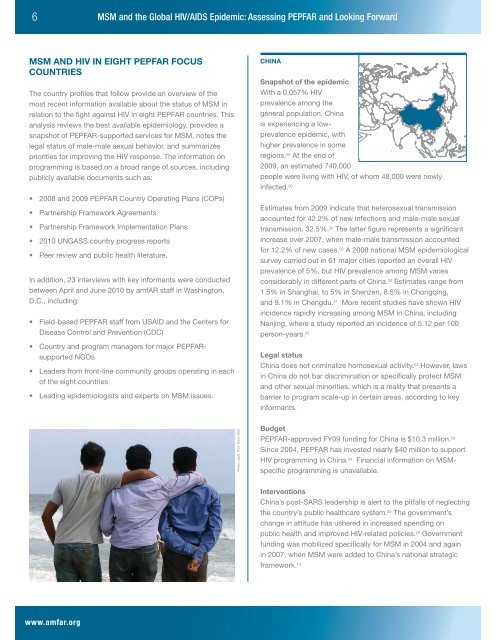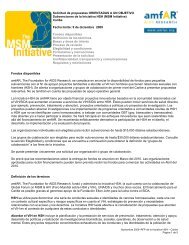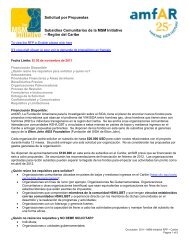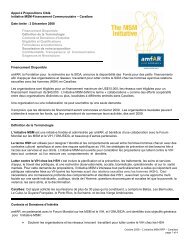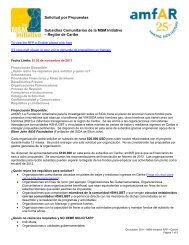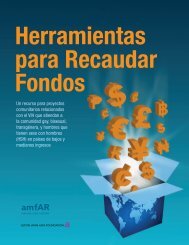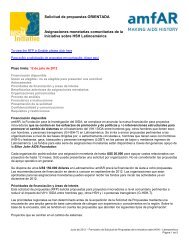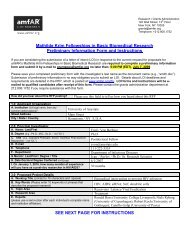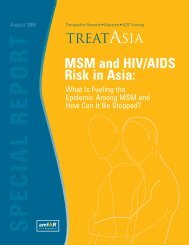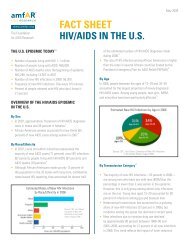Issue Brief: MSM and the Global HIV/AIDS Epidemic - amfAR
Issue Brief: MSM and the Global HIV/AIDS Epidemic - amfAR
Issue Brief: MSM and the Global HIV/AIDS Epidemic - amfAR
You also want an ePaper? Increase the reach of your titles
YUMPU automatically turns print PDFs into web optimized ePapers that Google loves.
6<br />
<strong>MSM</strong> <strong>and</strong> <strong>the</strong> <strong>Global</strong> <strong>HIV</strong>/<strong>AIDS</strong> <strong>Epidemic</strong>: Assessing PEPFAR <strong>and</strong> Looking Forward<br />
<strong>MSM</strong> AND <strong>HIV</strong> IN EIGHT PEPFAR FOCUS<br />
COUNTRIES<br />
The country profiles that follow provide an overview of <strong>the</strong><br />
most recent information available about <strong>the</strong> status of <strong>MSM</strong> in<br />
relation to <strong>the</strong> fight against <strong>HIV</strong> in eight PEPFAR countries. This<br />
analysis reviews <strong>the</strong> best available epidemiology, provides a<br />
snapshot of PEPFAR-supported services for <strong>MSM</strong>, notes <strong>the</strong><br />
legal status of male-male sexual behavior, <strong>and</strong> summarizes<br />
priorities for improving <strong>the</strong> <strong>HIV</strong> response. The information on<br />
programming is based on a broad range of sources, including<br />
publicly available documents such as:<br />
• 2008 <strong>and</strong> 2009 PEPFAR Country Operating Plans (COPs)<br />
• Partnership Framework Agreements<br />
• Partnership Framework Implementation Plans<br />
• 2010 UNGASS country progress reports<br />
• Peer review <strong>and</strong> public health literature.<br />
In addition, 23 interviews with key informants were conducted<br />
between April <strong>and</strong> June 2010 by <strong>amfAR</strong> staff in Washington,<br />
D.C., including:<br />
• Field-based PEPFAR staff from USAID <strong>and</strong> <strong>the</strong> Centers for<br />
Disease Control <strong>and</strong> Prevention (CDC)<br />
• Country <strong>and</strong> program managers for major PEPFARsupported<br />
NGOs<br />
• Leaders from front-line community groups operating in each<br />
of <strong>the</strong> eight countries<br />
• Leading epidemiologists <strong>and</strong> experts on <strong>MSM</strong> issues.<br />
Photo credit: Piotr Bizior/SXC<br />
CHINA<br />
Snapshot of <strong>the</strong> epidemic<br />
With a 0.057% <strong>HIV</strong><br />
prevalence among <strong>the</strong><br />
general population, China<br />
is experiencing a lowprevalence<br />
epidemic, with<br />
higher prevalence in some<br />
regions. 20 At <strong>the</strong> end of<br />
2009, an estimated 740,000<br />
people were living with <strong>HIV</strong>, of whom 48,000 were newly<br />
infected. 20<br />
Estimates from 2009 indicate that heterosexual transmission<br />
accounted for 42.2% of new infections <strong>and</strong> male-male sexual<br />
transmission, 32.5%. 20 The latter figure represents a significant<br />
increase over 2007, when male-male transmission accounted<br />
for 12.2% of new cases. 20 A 2008 national <strong>MSM</strong> epidemiological<br />
survey carried out in 61 major cities reported an overall <strong>HIV</strong><br />
prevalence of 5%, but <strong>HIV</strong> prevalence among <strong>MSM</strong> varies<br />
considerably in different parts of China. 20 Estimates range from<br />
1.5% in Shanghai, to 5% in Shenzen, 8.5% in Chongqing,<br />
<strong>and</strong> 9.1% in Chengdu. 21 More recent studies have shown <strong>HIV</strong><br />
incidence rapidly increasing among <strong>MSM</strong> in China, including<br />
Nanjing, where a study reported an incidence of 5.12 per 100<br />
person-years. 22<br />
Legal status<br />
China does not criminalize homosexual activity. 23 However, laws<br />
in China do not bar discrimination or specifically protect <strong>MSM</strong><br />
<strong>and</strong> o<strong>the</strong>r sexual minorities, which is a reality that presents a<br />
barrier to program scale-up in certain areas, according to key<br />
informants.<br />
Budget<br />
PEPFAR-approved FY09 funding for China is $10.3 million. 24<br />
Since 2004, PEPFAR has invested nearly $40 million to support<br />
<strong>HIV</strong> programming in China. 24 Financial information on <strong>MSM</strong>specific<br />
programming is unavailable.<br />
Interventions<br />
China’s post-SARS leadership is alert to <strong>the</strong> pitfalls of neglecting<br />
<strong>the</strong> country’s public healthcare system. 25 The government’s<br />
change in attitude has ushered in increased spending on<br />
public health <strong>and</strong> improved <strong>HIV</strong>-related policies. 25 Government<br />
funding was mobilized specifically for <strong>MSM</strong> in 2004 <strong>and</strong> again<br />
in 2007, when <strong>MSM</strong> were added to China’s national strategic<br />
framework. 13<br />
www.amfar.org


